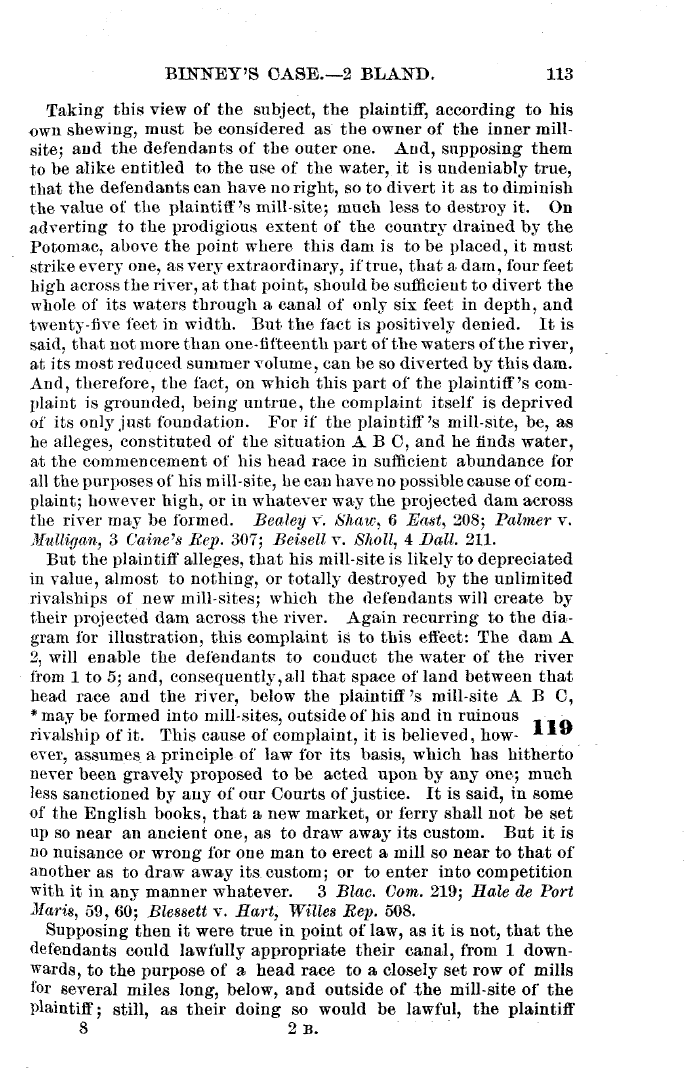|
BINNEY'S CASE.-2 BLAND. 113
Taking this view of the subject, the plaintiff, according to his
own skewing, must be considered as the owner of the inner mill-
site; and the defendants of the outer one. And, supposing them
to be alike entitled to the use of the water, it is undeniably true,
that the defendants can have no right, so to divert it as to diminish
the value of the plaintiff's mill-site; much less to destroy it. On
adverting to the prodigious extent of the country drained by the
Potomac, above the, point where this dam is to be placed, it must
strike every one, as very extraordinary, if true, that a dam, four feet
high across the river, at that point, should be sufficient to divert the
whole of its waters through a canal of only six feet in depth, and
twenty-five feet in width. But the fact is positively denied. It is
said; that not more than one-fifteenth part of the waters of the river,
at its most reduced summer volume, can be so diverted by this dam.
And, therefore, the fact, on which this part of the plaintiff's com-
plaint is grounded, being untrue, the complaint itself is deprived
of its only just foundation. For if the plaintiff's mill-site, be, as
he alleges, constituted of the, situation A B C, and he finds water,
at the Commencement of his head race in sufficient abundance for
all the, purposes of his mill-site, he can have no possible cause of com-
plaint; however high, or in whatever way the projected dam across
the river may be formed. Bealey v. Shaw, 6 East, 208; Palmer v.
31u.dligan, 3 Carne's Rep. 307; Beisell v. ,Shop, 4 Dall. 211.
But the plaintiff' alleges, that his mill-site is likely to depreciated
in value, almost to nothing, or totally destroyed by the unlimited
rivalships of new mill-sites; which the defendants will create by
their projected dam across the river. Again recurring to the dia-
gram for illustration, this complaint is to this effect: The dam A
2, will enable the defendants to conduct the water of the river
from 1 to 5; and, consequently, all that space of land between that
head race and the river, below the plaintiff's mill-site A B C,
* may be formed into mill-sites, outside of his and in ruinous
rivalship of it. This cause of complaint, it is believed, how- 11
ever, assumes a principle of law for its basis, which has hitherto
never been gravely proposed to be acted upon by any one; much
less sanctioned by any of our Courts of justice. It is said, in some
of the English books, that a new market, or ferry shall not be set
up so near an ancient one, as to draw away its custom. But it is
no nuisance or wrong for one man to erect a mill so near to that of
another as to draw away its custom; or to enter into competition
with it in any manner whatever. 3 Btac. Com. 219; .Hate de Port
Maris, 59, 60; Btessett v. Hart, Wibles Rep. 548.
Supposing then it were true in point of law, as it is not, that the
defendants could lawfully appropriate their canal, from 1 down-
wards, to the purpose of a head race to a closely set row of mills
for several miles long, below, anti outside of -the mill-site of the
plaintiff; still, as their doing so would be lawful, the plaintiff
9 2 B.
|

